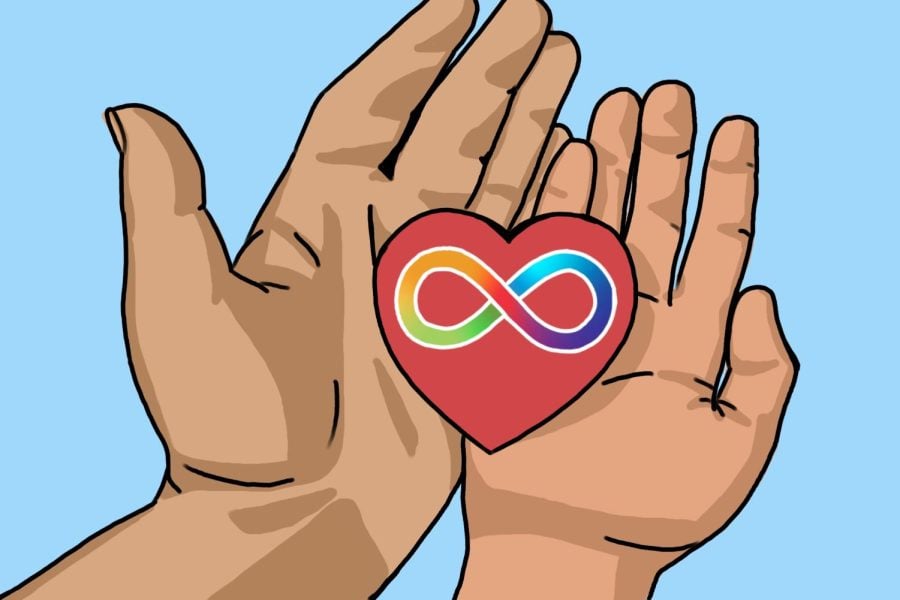NU faculty commemorate Autism Acceptance Month with research, education
The “rainbow spectrum” is often used to visually represent the range of abilities and traits of autistic people. April is Autism Acceptance and Awareness Month.
April 17, 2023
April marks the start of Autism Awareness and Acceptance Month, which is dedicated to promoting inclusion and understanding of autistic people. At Northwestern, faculty are continuing to make strides in both research and education to further understand ASD.
Communication Prof. Molly Losh, who teaches a course on autism and leads the Neurodevelopmental Disability Lab within the communication sciences and disorders department, has studied autism since she was an undergraduate student. She said new data from the Centers for Disease Control and Prevention — which suggest one out of every 36 school-age children have autism — shed light on the importance of understanding the relatively common condition.
“Autism is a broad spectrum condition where features can range from differences in communication style, personality and preferences, to many people on the spectrum being quite severely affected and not developing language or being able to live independently,” Losh said.
Losh’s lab studies autism from a family genetic perspective, meaning research focuses primarily on the language and communication features of autism and how they might be tied to different areas of the brain, variation in brain activity and underlying genetic influences.
She described the lab’s broader goal as tying underlying biology to observable behavior — with strong evidence connecting language and communication profiles of those with and without an ASD diagnosis.
“Autism is a part of complex abilities and traits that we all have, and I think with that recognition, we’ve seen a lot of increased acceptance, awareness, more social integration for autistic individuals, which has just been wonderful,” Losh said.
On the first day of CSD 382: Autism Spectrum Disorder, Losh said she loves teaching the class Spring Quarter because it overlaps with Autism Awareness and Acceptance Month, Weinberg junior Mirabella Johnson said.
Johnson said while the course is still in its introductory phase, many “good conversations and questions” have come up in class.
“Many of us know someone with autism spectrum disorder,” Johnson said. “The month is just such a great way to educate one another and provide resources and support for the community. It’s a great way to push for advocacy, to advance research and to also importantly bridge gaps to increase support and understanding for children and adults with autism and their support systems which back them.”
Feinberg Prof. Peter Penzes, director of the Center of Autism and Neurodevelopment, said his research focuses on how defective synapses — the junctions where neurons communicate with one another — can cause neurodevelopmental disorders.
Penzes said at the center, researchers use human patient-derived neurons and “model systems” like mutant mice to study how different genetic mutations can cause autism, how they affect brain development and circuits and how they affect behavior.
Penzes added that parallel studies which use induced pluripotent stem cell derived neurons — brain cells analogous to those of a specific patient — can show uniquely human features of brain cells of autistic people. Using this information, they aim to develop new therapeutics.
“Autism is 50-90% genetic but the actual genes that, when mutated, cause the disease are only beginning to be discovered,” Penzes said. “In the past five years, very large studies, involving over 100,000 human participants, have uncovered over 100 of such genes.”
Penzes described autism as a collection of subtypes caused by various genetic mutations. Penzes said while a number of genes have recently been discovered to play a role in autism, how these gene mutations lead to autism is still not well understood.
Losh also said the term “autism spectrum” is critical in capturing the complexity and heterogeneity of autism. Autism used to be viewed as black-and-white, but like many other complex neurodevelopmental conditions, she said it is best represented as a spectrum.
“Science and understanding is advancing at a faster pace than ever in a way that is really closely wedded with increased public understanding and awareness, to the end result of the betterment of autistic persons’ lives,” Losh said.
Email: [email protected]
Twitter: @noracollins02
Related Stories:
— NU researchers discover new therapeutic drug that could treat autism subtype
— NU researchers seek to increase accessibility of motorized wheelchairs
— Chan Zuckerberg Initiative selects Northwestern to co-lead new Chicago biohub


